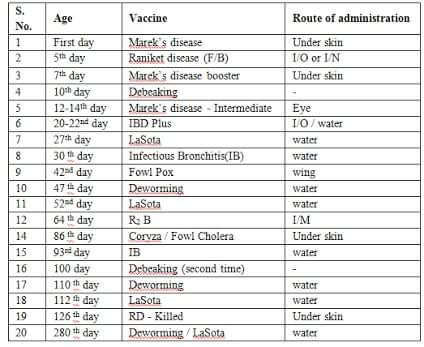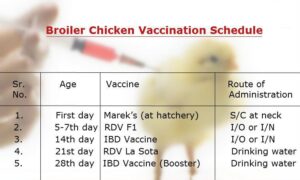Vaccination Programs in Poultry
As in human medicine, in the last 50-60 years, there has been tremendous progress in the development of vaccines to protect chickens against both viral and bacterial diseases.
In fact, vaccines have become such a common every day part of poultry production that it is easy to be complacent and forget that if we were to go back 60 years, poultry producers could suffer massive losses in flocks in rear due to viral infection such as Mareks disease for which no vaccines were available.
Concern is often expressed about the number of vaccines administered to pullets during the rearing period and this is perhaps understandable so it is important to consider why the bird may require these vaccinations.
Why vaccinate?
Vaccination in rear may be given to:
1) Protect the pullet against those diseases which can prove fatal to the bird, for example, Mareks disease, Gumboro disease.
2) To protect the pullet against diseases which may cause problems with egg production or shell quality if the bird becomes infected in lay, for example, Infectious Bronchitis, Mycoplasma gallisepticum.
3) To give the pullets some protection against diseases which are of public health significance, for example, Salmonella.
How do vaccines work?
Vaccination works by exploiting the most natural of bodily reactions. When a bird meets an infection, the body’s defences (the immune system) reacts on two levels. First, it mobilises cells and chemicals to kill the invading organism and stop disease occurring. Secondly, it triggers a memory system in the body to respond quickly should the bird meet that infection again at some time in the future. This can be by priming cells to fight infection or by the production of antibodies which are complex proteins circulating in the bloodstream. Antibodies will neutralise infections which have managed to reach the bloodstream. As an added bonus in breeding chickens, these antibodies can be passed to the newly hatched chick via the yolk sac and protect the chick for the first few weeks of life from the bugs that the parent hen has been previously exposed to.
These protective measures provided by the immune system are highly specific, ie they will only protect the bird against the specific organism they have been previously exposed to. We use vaccination to exploit this mechanism by “priming” the bird to a range of diseases which might be a risk to them in later life.
Vaccines can now be produced against a wide range of organisms, and poultry vaccines are currently available against viral, bacterial and some parasitic diseases.
Types of vaccine for poultry
Vaccines available for poultry fall into two broad categories:
• Live vaccines. These are modified version or naturally occurring mild strains of the disease organism. This type of vaccine will trigger the birds’ immune system to produce antibodies but without causing disease in the bird. Examples of this type of live vaccine include Infectious Bronchitis, Infectious Bronchitis variant vaccines, Newcastle disease vaccine, coccidiosis vaccine and Mareks disease vaccine.
• Killed or inactivated vaccines. These vaccines, as their name suggests, are killed infectious organisms which can trigger birds’ immune system to respond. Many of these require previous priming with a live vaccine to produce the best immune response in the bird.
How are vaccines given to the bird?
The main methods of vaccine administration are:
1) By injection
2) Via drinking water
3) By spray application
4) By eye drop
5) By spray on feed (coccidiosis vaccine)
6) In ovo administration into the egg prior to hatching.
The last two methods are not commonly used for vaccination of laying flocks.
Vaccine administration
Vaccine must be administered to the birds in such a way that the whole flock can respond in the most efficient manner.
Inactivated (killed) vaccines
Injection is the usual route for killed vaccines as these vaccines don’t spread from bird to bird so one needs to be certain each bird gets its own individual dose. These vaccines can be given under the skin (subcutaneously) or into the leg or breast muscle (intramuscularly). Vaccines are usually administered by well trained and highly skilled vaccination gangs.
As this type of vaccination involves sticking a needle into the bird and breaking the skin, it is imperative that the highest standards of hygiene and cleanliness are observed during the vaccination process.
Live vaccines
Live vaccines are, in many ways, easier to administer and are ideal for mass administration to large flocks as they can be given via drinking water or by spray or, in some cases, by individual eye drop.
Common examples of live vaccines include Infectious Bronchitis, Newcastle Disease, TRT, ILT and AE vaccines.
Live vaccines are often given to act as primers during the early part of the rearing period to stimulate the birds’ immune system so that when the bird receives a killed vaccine prior to transfer to the laying site, the immune system is primed to give good antibody response so that the bird has a long lasting immunity.
Drinking water vaccination
Drinking water administration of vaccines might be considered the easiest option as it requires little in the way of expensive equipment and enables a large number of birds to be vaccinated in a short space of time.
However, effective vaccination requires attention to detail, in particular consideration of water intake in the flock over the period during which vaccine is administered.
There must be a sufficient number of well cleaned, well maintained drinkers and a clean system for delivering the vaccine.
Some live vaccines can also be administered by spray. This method is especially good for protecting against infections which attack the respiratory tract as the vaccine has been delivered to where it needs to produce its best protective effect, ie the lining of the nose and the windpipe.
The key with success when spraying vaccines is to supply the right droplet size for as many birds as possible so the vaccine reaches the part of the bird you want to reach! This requires good spraying technique and good equipment.
Increasingly, spray vaccination is used during the laying period to provide “top-up” vaccination against Infectious Bronchitis and Infectious Bronchitis variants as these virus infections are a common cause of problems with egg production and shell quality.
This top-up vaccination works by delivering the viral vaccines to the upper respiratory tract, further stimulating birds’ existing immunity and preventing viral infections penetrating further into the bird and reaching the oviduct. Generally, vaccines are not licenced for use in birds in lay so any additional vaccination given during this period should be discussed with your veterinary surgeon to make sure that the programme is appropriate for your flock.
Poultry vaccine companies offer excellent technical support in on farm auditing of your vaccination technique, both with live and inactivated vaccines and this can be arranged through your veterinary surgeon.
Can the bird respond to such a large number of vaccines in the rearing period?
Experimental research in practical experience has shown that pullets are able to respond well to a wide range of vaccines as long as they are good quality products and applied appropriately. In the wild, birds would also be exposed to all sorts of disease challenges which would stimulate immunity and in part we are recreating this with vaccines to give our birds the best possible protection during the production period.
To date, there has been no evidence that we have reached any sort of “overload” of the system in the range of vaccines administered to laying flocks.
In order to give the optimal response to vaccination, birds need to be healthy and fit when vaccine is administered. The antibodies birds produce in response to vaccination are made up of proteins and to produce good antibodies birds need to be in good health at the time of the vaccination and on an appropriate ration to provide the ingredients to make up these antibody proteins.


Reference-Vijay Sai Medical


